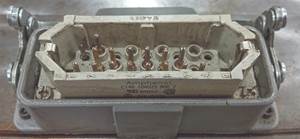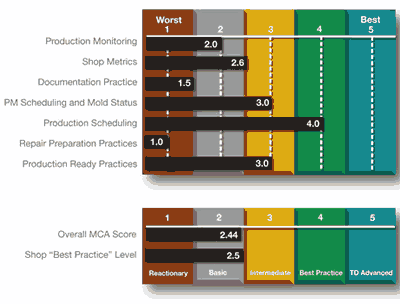Seven Habits of Highly Effective Repair Technicians
Effective, efficient mold repair is a unique skill when complemented with knowing what it takes to keep molds running optimally and reliably.
Realizing there are many maintenance styles among repair technicians, I thought it would be interesting to “poll” some toolmakers, repair techs, maintenance supervisors and managers to see what habits they believe a skilled and experienced repair technician should possess. This informal poll boils down to a good list of workbench habits that will enhance technical skills and provide some rules of thumb for all maintenance-minded craftsmen:
1. Do your mold homework.
Investigate the past. Find out as much as you can about how the mold has been running before it landed on your bench. Developing a maintenance plan helps you to think tasks through and provides a roadmap for complex issues.
2. Work systematically.
Develop an initial repair preparation routine. It never pays to rip a mold apart and dive into cleaning tooling before you troubleshoot the issues or make any repairs. Little things—such as initial component galling, excess residue in vents, residue build-up where there are no vents, plating wear, dry bushings, etc.—are critical to accurate diagnosis of a mold health issue. Also, it is not good practice to mix the tools used in the various repair stages such as precision measuring tools with cleaning solvents, abrasive media, pry bars and hammers and paperwork.
3. Document what you do.
It is not uncommon for a repair tech in a busy shop to be pulled off one job to start another or to repair a mold in the press. Using a repair sheet to document what you have already done and where you left off will reduce mistakes and also allows whoever follows you on the mold (shift change) an idea of what you were doing.
4. Be professional.
A fleet of molds are worth millions of dollars. Don’t become jaded to this fact through daily familiarity. Don’t be the shop prankster, be disruptive at the wrong time or be dangerous to work around. Use good tools and use them correctly. Mistakes are usually the result of using the wrong tools the wrong way and a lack of focus during the critical assembly stage. Also, flinging tools across the shop when you are upset or pounding something together because you ran out of patience will get you more than a nickname.
5. Develop, practice and preach hand skills.
Most tasks in mold repair require the skill of feel or touch to accurately gage if a component is too tight, too loose or just the right running fit for the application. Components that are out-of-round, tooling that is not properly aligned, along with hidden dings or burrs are physical flags that are sometimes missed through excessive force. Removing and installing tooling without damaging delicate and critical shut-offs is a skill that takes a clear line from head to hands, and continuous honing to keep sharp.
6. Be a team player.
Mold repair knowledge is many times tech specific in that it takes the right guy to repair a particular mold. This practice handcuffs production while they wait for Bob to get back from vacation or break. Communicate with co-workers and share your mold experience.
7. Train, train and train.
Every mold, every product presents a variety of issues that can challenge your physical, mechanical and troubleshooting/analytical skills. Reading trade magazines, attending seminars and conferences that teach practical mold repair techniques is invaluable to this craft. Learn about plastic flow and resin characteristics. For molders, finding a qualified repair technician is a difficult task. Someone who knows steels, plating, mold and hot runner types and functions and that can work efficiently and unsupervised can just about name their own wage, work anywhere they desire and never have to worry about being unemployed for long.
Effective, efficient mold repair is a unique skill when complemented with specific technical knowledge of today’s molds and what it takes to keep them running optimally and reliably.
Practice these seven habits and you and your company will reap the rewards. Mold maintenance will never die—it just gets more complex as mold designers try to get more and more from these expensive works of art.
Related Content
Precision Welding Services Offer Rapid Turnaround Mold Repair and Reduced Molder Downtime
X-Cell Tool & Mold relies on outsourced, high-quality welding repairs from Lewis-Bawol Welding to ensure its customers' molds are back in production quickly and affordably.
Read MoreHow to Maintain Heaters, Thermocouples, Valve Gates and Controls
An examination of real-world problems and solutions involving hot runner system maintenance.
Read MoreLaser Welding Versus Micro Welding
The latest battle in finely detailed restoration/repair of mold materials.
Read MoreQuestions and Considerations Before Sending Your Mold Out for Service
Communication is essential for proper polishing, hot runner manifold cleaning, mold repair, laser engraving and laser welding services.
Read MoreRead Next
Beyond the Classroom: Mold Maintenance Products That Work
Leaving injection mold maintenance to chance is a costly oversight. Using standardized methods of improvement, as explained here, can yield real change to company practices as well as significant returns on a company’s tooling investment.
Read MoreAre You a Moldmaker Considering 3D Printing? Consider the 3D Printing Workshop at NPE2024
Presentations will cover 3D printing for mold tooling, material innovation, product development, bridge production and full-scale, high-volume additive manufacturing.
Read MoreReasons to Use Fiber Lasers for Mold Cleaning
Fiber lasers offer a simplicity, speed, control and portability, minimizing mold cleaning risks.
Read More









.jpg;maxWidth=300;quality=90)






_300x250 1.png;maxWidth=300;quality=90)








